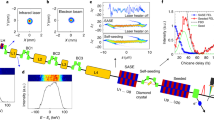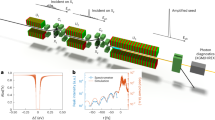Abstract
X-ray free-electron lasers (XFELs)1,2 are widely operated on the basis of self-amplified spontaneous emission (SASE)3,4, where spontaneous radiation from the electron beam is amplified along the magnetic field in undulators. Despite their high intensities, SASE-XFELs have a broad spectrum due to the stochastic starting-up process5. To narrow the bandwidth, self-seeding has been proposed6,7 and recently demonstrated8,9, where the seed pulse produced by monochromatizing the SASE-XFELs from the first section of undulators using a thin crystal in transmission geometry is amplified in the remaining undulators. Here, we present an efficient self-seeding scheme using the Bragg reflection to produce a seed pulse. We applied this scheme to SPring-8 Angstrom Compact free-electron LAser (SACLA)10, and produced nearly Fourier-transform-limited XFEL pulses that correspond to an increase in spectral brightness by a factor of six compared with SASE-XFELs. This achievement will not only enhance the throughput of present XFEL experiments but also should open new opportunities for X-ray science.
This is a preview of subscription content, access via your institution
Access options
Access Nature and 54 other Nature Portfolio journals
Get Nature+, our best-value online-access subscription
$29.99 / 30 days
cancel any time
Subscribe to this journal
Receive 12 print issues and online access
$209.00 per year
only $17.42 per issue
Buy this article
- Purchase on Springer Link
- Instant access to full article PDF
Prices may be subject to local taxes which are calculated during checkout




Similar content being viewed by others
Data availability
The data that support the plots within this paper and other findings of this study are available from the corresponding author upon reasonable request.
References
McNeil, B. W. J. & Thompson, N. R. X-ray free-electron lasers. Nat. Photon. 4, 814–821 (2010).
Huang, Z. & Kim, K. J. Review of X-ray free-electron laser theory. Phys. Rev. Spec. Top. Accel. Beams 10, 034801 (2007).
Kondratenko, A. M. & Saldin, E. L. Generation of coherent radiation by a relativistic electron beam in an ondulator. Part. Accel. 10, 207–216 (1980).
Bonifacio, R., Pellegrini, C. & Narducci, L. M. Collective instabilities and high-gain regime in a free-electron laser. Opt. Commun. 50, 373–377 (1984).
Saldin, E. L., Schneidmiller, E. A. & Yurkov, M. V. The Physics of Free Electron Lasers (Springer, Berlin, 1999).
Feldhaus, J. et al. Possible application of X-ray optical elements for reducing the spectral bandwidth of an X-ray SASE FEL. Opt. Commun. 140, 341–352 (1997).
Saldin, E. L., Schneidmiller, E. A., Shvyd’ko, Yu. V. & Yurkov, M. V. X-ray FEL with a meV bandwidth. Nucl. Instrum. Methods A 475, 357–362 (2001).
Amann, J. et al. Demonstration of self-seeding in a hard-X-ray free-electron laser. Nat. Photon. 6, 693–698 (2012).
Emma, C. et al. Experimental demonstration of fresh bunch self-seeding in an X-ray free electron laser. Appl. Phys. Lett. 110, 154101 (2017).
Ishikawa, T. et al. A compact X-ray free-electron laser emitting in the sub-Ångström region. Nat. Photon. 6, 540–544 (2012).
Inubushi, Y. et al. Determination of the pulse duration of an X-ray free electron laser using highly resolved single-shot spectra. Phys. Rev. Lett. 109, 144801 (2012).
Behrens, C. et al. Few-femtosecond time-resolved measurements of X-ray free-electron lasers. Nat. Commun. 5, 3762 (2014).
Gutt, C. et al. Single shot spatial and temporal coherence properties of the SLAC linac coherent light source in the hard X-ray regime. Phys. Rev. Lett. 108, 024801 (2012).
Inoue, I. et al. Characterizing transverse coherence of an ultra-intense focused X-ray free-electron laser by an extended Young’s experiment. IUCrJ 2, 620–626 (2015).
Tamasaku et al. X-ray two-photon absorption competing against single and sequential multiphoton processes. Nat. Photon. 8, 313–316 (2014).
Inada, T. et al. Search for photon–photon elastic scattering in the X-ray region. Phys. Lett. B 732, 356–359 (2014).
Togashi, T. et al. Extreme ultraviolet free electron laser seeded with high-order harmonic of Ti:sapphire laser. Opt. Express 19, 317–324 (2011).
Lambert, G. et al. Injection of harmonics generated in gas in a free-electron laser providing intense and coherent extreme-ultraviolet light. Nat. Phys. 4, 296–300 (2008).
Allaria, E. et al. Two-stage seeded soft-X-ray free-electron laser. Nat. Photon. 7, 913–918 (2013).
Emma, P. et al. First lasing and operation of an Angstrom wavelength free-electron laser. Nat. Photon. 4, 641–647 (2010).
Lindberg, R. R. & Shvyd’ko, Yu. V. Time dependence of Bragg forward scattering and self-seeding of hard X-ray free-electron lasers. Phys. Rev. Spec. Top. Accel. Beams 15, 050706 (2012).
Geloni, G., Kocharyan, V. & Saldin, E. A novel self-seeding scheme for hard X-ray FELs. J. Mod. Opt. 58, 1391–1403 (2011).
Yabashi, M. & Tanaka, T. Self-seeded FEL emits hard X-rays. Nat. Photon. 6, 648–649 (2012).
Tono, K. et al. Beamline, experimental stations and photon beam diagnostics for the hard X-ray free electron laser of SACLA. New J. Phys. 15, 083035 (2013).
Osaka, T. et al. A micro channel-cut crystal X-ray monochromator for a self-seeded hard X-ray free-electron laser. Preprint at http://arxiv.org/abs/1811.01860 (2018).
Inoue, I. et al. X-ray Hanbury Brown–Twiss interferometry for determination of ultrashort electron-bunch duration. Phys. Rev. Accel. Beams 21, 080704 (2018).
Kameshima, T. et al. Development of an X-ray pixel detector with multi-port charge-coupled device for X-ray free-electron laser experiments. Rev. Sci. Instrum. 85, 033110 (2014).
Acknowledgements
The authors thank Y. Sano, T. Hirano, Y. Morioka, Y. Kohmura and K. Yamauchi for their support in the characterization of the silicon channel-cut crystal monochromator. The authors also thank D. Zhu, A. Robert and Y. Feng for sharing their experiences on transmission self-seeding at the Linac Coherent Light Source (LCLS). The authors are grateful for the valuable advice from K. Tamasaku. The authors acknowledge T. Hasegawa, S. Tanaka, Y. Tajiri and other members of the SACLA team for help with the accelerator operation and data analysis. This research was partially performed with the approval of the Japan Synchrotron Radiation Research Institute (JASRI) (Proposal No. 2018A8040).
Author information
Authors and Affiliations
Contributions
M. Yabashi, T.T. and H.T. conceived the idea of self-seeding using a Si channel-cut crystal monochromator. T.O., I.I. and M. Yabashi designed and characterized the Si(111) channel-cut crystal monochromator. I.I. and T.O. designed the commissioning plan with advice from all co-authors. All of the co-authors jointly performed the commissioning of the reflection self-seeding. I.I. and T.O. analysed the experimental data. T.T. and R.K. performed simulation studies. I.I., T.O., T.T. and M. Yabashi co-wrote the manuscript.
Corresponding author
Ethics declarations
Competing interests
The authors declare no competing interests.
Additional information
Publisher’s note: Springer Nature remains neutral with regard to jurisdictional claims in published maps and institutional affiliations.
Supplementary information
Supplementary Information
Supplementary Notes and Figures.
Rights and permissions
About this article
Cite this article
Inoue, I., Osaka, T., Hara, T. et al. Generation of narrow-band X-ray free-electron laser via reflection self-seeding. Nat. Photonics 13, 319–322 (2019). https://doi.org/10.1038/s41566-019-0365-y
Received:
Accepted:
Published:
Issue Date:
DOI: https://doi.org/10.1038/s41566-019-0365-y
This article is cited by
-
Chaotic dynamics in X-ray free-electron lasers with an optical undulator
Scientific Reports (2024)
-
Low-loss stable storage of 1.2 Å X-ray pulses in a 14 m Bragg cavity
Nature Photonics (2023)
-
Attosecond coherent control of electronic wave packets in two-colour photoionization using a novel timing tool for seeded free-electron laser
Nature Photonics (2023)
-
An X-ray free-electron laser with a highly configurable undulator and integrated chicanes for tailored pulse properties
Nature Communications (2023)
-
Cascaded hard X-ray self-seeded free-electron laser at megahertz repetition rate
Nature Photonics (2023)



